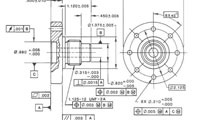GD&T
GD&T (Geometric Dimensioning and Tolerancing) is basically a system which is used to define and communicate engineering tolerances. In this method, the geometry of mechanical parts is precisely defined. It allows engineers, designers, and fabricators to communicate engineering tolerances and accurately and precisely define a physical dimension or property of a material or a measured value.
Learning GD&T will be helpful for one to precisely define the nominal geometry of parts and assemblies. GD&T is widely used in automotive, aerospace, electronic, and commercial design and manufacturing industries.
Knowledge and exposure of GD&T course which consists of dimensions, symbols, tolerances, definitions, rules, and conventions. GD&T is an important skill for engineers, designers and other CAD users.
CADD Centre will help you to ace the associated features of GD&T:
- Dimensioning Specifications: Helpful for defining the nominal, as-modeled or as-intended geometry of parts.
- Tolerancing Specifications: Helpful for defining allowable variation for form and the size of individual features and allowable variation in orientation and location between features.
- Geometric Characteristics: Engineers can use symbolic language for engineering drawings & computer generated 3D solid models to explicitly describing nominal geometry and its acceptable variations. The geometric symbols include straightness, circularity, flatness, cylindricity, surface, the profile of a line, perpendicularity, and angularity.



